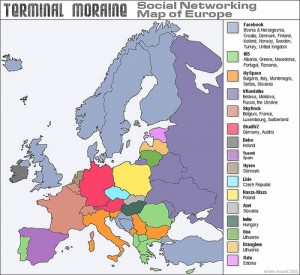No matter what your product or service, you have to remember your audience and focus on their needs first. If you are marketing to an audience of 10 year old American girls, you will need to have a completely different approach (from language to usage to packaging) than if you are marketing your products to 45 year old Australian men. This is true of print and television marketing, so we need to keep in mind that when promoting social marketing not every group will find the same features and functions appealing.
This is exactly the case with social media in Europe. Although on this side of the pond, we North Americans tend to think that our way of approaching and using social media is the only way it is done, those who create the programs we use for it need to be aware that Europeans do it a bit differently. Bas van den Beld writes about just this issue in his article “How Europeans Engage With Social Media”.
Although Europeans are online and do use social media, they “are using social media in very practical way, they are looking for news updates, to do research before shopping or for their jobs, and to find “how-tos.” The actual “social element”—staying in touch with friends online—is only the third most popular activity (behind search and email) when looking at what Europeans are doing online.” And although Europeans do use sites like Facebook, Twitter, MySpace, Friendster and LinkedIn, they have a definite preference for locally grown social media applications.
And, broken down country by country, Europeans have different tastes and needs for their online experiences. While the UK, Russia, and Spain are the most active in the social media scene, Italy uses social media for education purposes, and both the UK and Germany use it mostly for research. Germany and France are the least active social media users in Europe.
Bas van den Beld points out that when attempting to make inroads into European markets, social media creators need to keep the following points in mind:
– Europeans like to research, so make sure they can find that information they are looking for, and use searching to funnel traffic to your social media efforts.
– It might initially be difficult to get Europeans to share, but if you get them involved they will.
– Create social applications that provide a benefit and be there with a purpose; Europeans want to see a reason for committing their time.
– Give Europeans relevant news and information.
– Europeans like to see European initiatives, so try sponsoring local efforts.
– And finally, don’t think every European is the same—we’re all different and you need to satisfy our different needs to be successful.

